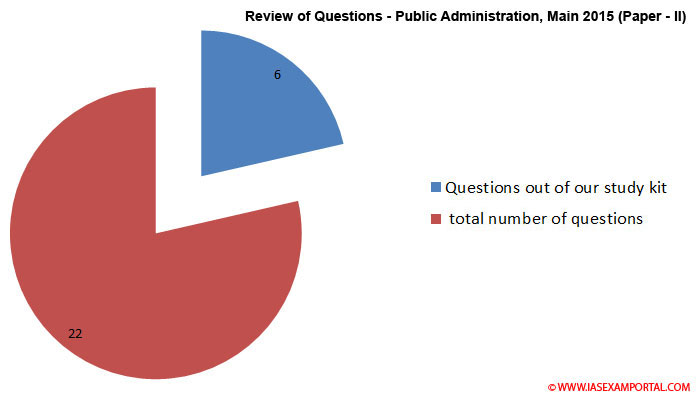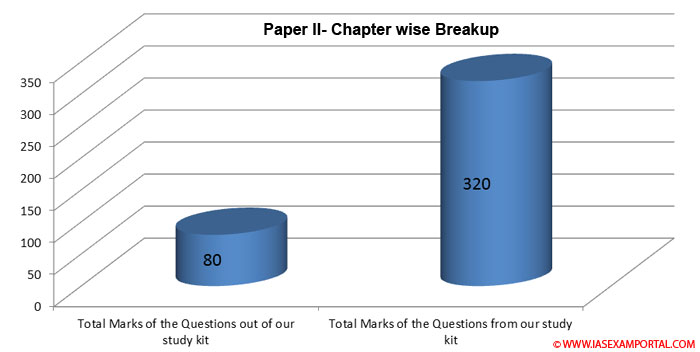Review of Questions - Public Administration, Main 2015 (Paper - II)
Review of Questions - Public Administration, Main 2015 (Paper - II)
UPSC comes with new word limits here: 10 marks = 150 words
So 15 marks = 225 words & 20 marks = 300 words.
Each Paper (I and II) with 250 marks and 3 hours’ time limit.
Eight Questions in two sections (A and B)
Question Paper Specific Instructions
- Please read each of the following instructions carefully before attempting questions:
- There are EIGHT questions divided in two SECTIONS and printed both in HINDI and in ENGLISH.
- Candidate has to attempt FIVE questions in all.
- Questions no. 1 and 5 are compulsory and out of the remaining, THREE are to be attempted choosing at least ONE from each section.
- The number of marks carried by a question/part is indicated against it.
- Answer must be written in the medium authorized in the Admission Certificate which must be stated clearly on the cover of this Question-cum-Answer (QCA) Booklet in the space provided. No marks will be given for answer written in a medium other than the authorized one.
- Word limit in questions, wherever specified, should be adhered to.
- Attempts of questions shall be counted in chronological order. Unless struck off, attempt of a question shall be counted even if attempted partly. Any page or portion of left blank in the answer book must be clearly struck off.
Questions out of our study kit – 6
Total number of questions - 22

Section-A
Q1. Attempt all of the following in about 150 words each: 10×5=50
A. “Democracy within bureaucracy is likely to reduce its effectiveness.” Do you agree with this view? Argue your case. (Philosophical and Constitutional Framework of Government- From our Public Administration Study Kit - Page No-33 to 36)
B. “District Collector’s role in the development process has been overemphasized.” Comment on the statement. (District Administration since Independence- From our Public Administration Study Kit - Page No-223 to 224)
C. Why has District Planning been marginalized in many States and remained prominent in a few States? Explain. (Plans and Priorities- From our Public Administration Study Kit - Page No-168 to 169)
D. “Ordinance-making power of the Executive needs to be suitably restrained.” Examine it critically. (Union Government and Administration- From our Public Administration Study Kit - Page No- 72 to 75)
E. ‘Minimum government, maximum governance’ is not just a slogan but a philosophy of administration with enormous potentialities.” Do you agree? Give reasons for your answer. (Philosophical and Constitutional Framework of Government)
Q2. 20 + 20 + 10 Marks
A. To what extent has political culture influenced the administrative culture of India? Explain. 20 (Philosophical and Constitutional Framework of Government- From our Public Administration Study Kit - Page No- 30 to 32)
B. Briefly discuss the main recommendations of the Punchhi Commission (2010) on Centre-State relations for transforming Indian Federal System. 20 (Philosophical and Constitutional Framework of Government- Part of our Gist of National Administrative Committee Report, Public Administration Study Kit)
C. As Dr. B. R. Ambedkar observed, “the text of the Constitution can provide the organs of the State, but the final outcome of the governance process depends on how it has operationalized by the political parties and people”. Elucidate the statement. 10 (Philosophical and Constitutional Framework of Government)
Q3. 20 + 20 + 10 Marks
A. The objectives, approaches and organizational arrangements for decision-making of the NITI Aayog aim at restoring the federal character of the Indian polity. Explain. (Plans and Priorities- From our Current Public Administration Magazine, September 2014 Public Administration Study Kit - Page No-16 to 17)
B. Explain fully how a balance can be struck between autonomy and accountability of India’s public enterprises. (Public Sector Undertaking- From our Public Administration Study Kit - Page No-49 to 50)
C. “Decentralised governance must serve as an instrument of realizing social change and social justice.” Comment on the statement. (Rural Development- From our Public Administration Study Kit - Page No-293 to 296)
Q4. 20 + 20 + 10 Marks
A. Discuss the arguments for and against the National Judicial Appointments Commission Act, 2014. (Union Government and Administration)
B. “In very recent time, the role of the State Governor is found to be more of diplomatic than administrative nature.” Comment on the statement with suitable examples. (State Government and Administration- From our Public Administration Study Kit - Page No-192 to 194)
C. Comment on the recent changes in the approach and methodology of devolution of responsibilities and transfer of funds from the Union to the States. (State Government and Administration - From our Public Administration Study Kit - Page No-180 to 182)
Section-B
Q5. Attempt all of the following in about 150 words each: 10X5=50
A. Critically examine the concept of community policing as a tool for improving public-police relations. (Law and Order Administration- From our Public Administration Study Kit - Page No- 325 to 327)
B. Explain how budget can be used as a political instrument. (Financial Management- From our Public Administration Study Kit - Page No-256 to 257)
C. “Most Civil Servants in India are competent administrators, but they pay little attention to encourage people’s participation in decision-making.” Comment on the statement. (Significant Issues in Indian Administration- From our Public Administration Study Kit - Page No-345 to 347)
D. Do you think that the functioning of Panchayati Raj Institutions (PRIs), in practice, reflects genuine devolution of powers and resources? Give reasons for your answer. (Rural Development- From our Public Administration Study Kit - Page No-293 to 294)
E. “Information Communication Technology (ICT) improves the quality of public service delivery, but fails to check bribery.” Comment. (Civil Services- From our Public Administration Study Kit - Page No- 240 to 242)
Q6. 20 + 20 + 10 Marks
A. “Excellent ideas but poor implementation have characterised the administrative reforms in India since Independence.” Critically examine the statement giving examples from the Union and State Governments (Administrative Reforms since Independence- From our Public Administration Study Kit - Page No- 285 to 286)
B. Do you agree that there has been a serious governance-deficit in development administration in India? Give reasons for your answer and add your suggestions. (Philosophical and Constitutional Framework of Government- From our Public Administration Study Kit - Page No-37 to 40)
C. What are the major concerns of the Second Administrative Reforms Commission on Civil Service reforms? Indicate the current status of their implementation. (Administrative Reforms since Independence)
Q7. 20 + 20 + 10 Marks
A. How do the Union Government policies on Smart and AMRUT Cities address the problems of management of urban development? Explain. (Urban local Government- From our Current Public Administration Magazine, August 2015 Public Administration Study Kit - Page No-16 to 17)
B. Discuss the significance and role of the Central Paramilitary Forces in maintaining law and order and countering insurgency as well as terrorism. (Law and Order Administration- From our Public Administration Study Kit - Page No-320 to 323)
C. Discuss the major highlights of the reforms introduced from time-to-time in Central Civil Services Conduct Rules and add your own comments. (Civil Services- From our Public Administration Study Kit - Page No- 242 to 245)
Q8. 20 + 20 + 10 Marks
A. “Municipal governance in India is not sufficiently prepared to meet the challenges of frequent natural disasters.” Elucidate the statement and add your own suggestions. (Significant Issues in Indian Administration- From our Public Administration Study Kit - Page No-352 to 357)
B. Discuss critically the salient features of the National Investigation Agency (NIA) regarding its purposes and jurisdiction. (Law and Order Administration)
C. Argue the case for and against creating Indian Public Enterprises and Industrial Service for boosting the moribund public sector in India. (Public Sector Undertakings)
Paper II- Marks wise Breakup
Total Marks of the Questions out of our study kit – 80 Marks
Total Marks of the Questions from our study kit – 320 Marks

Paper II- Chapter wise Breakup
Indian Administration
1. Evolution of Indian Administration:- No question asked
2. Philosophical and Constitutional framework of government:- 6 Questions- 90
Marks
3. Public Sector Undertakings:- 2 Question- 30 Marks
4. Union Government and Administration:- 2 Questions- 30 Marks
5. Plans and Priorities:- 2 Questions- 30 Marks
6. State Government and Administration:- 2 Questions- 30 Marks
7. District Administration since Independence:- 1 Question- 10 Marks
8. Civil Services:- 2 Questions- 20 Marks
9. Financial Management:- 1 Question- 10 Marks
10. Administrative Reforms since Independence:- 2 Questions- 30 Marks
11. Rural Development:- 2 Questions- 20 Marks
12. Urban Local Government:- 1 Question- 20 Marks
13. Law and Order Administration:- 3 Questions- 50 Marks
14. Significant issues in Indian Administration:- 2 Questions- 30 Marks
